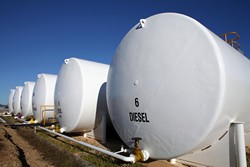How do unanchored liquid storage tanks perform in the event of earthquakes?
Being essential components of lifeline and industrial systems, liquid storage tanks need to be kept safe. But the harsh truth is that they aren’t: earthquake-caused failures have often resulted in spillage of toxic materials over the years, sometimes leading to disastrous effects. One of the most notable examples was the Izmir earthquake in 1999. Liquid storage tanks at the Tupras refinery were destroyed by fires and burned out of control for several days. Approximately 30 of the 45 tanks in the refinery were severely damaged, and some of the oil spilled into Izmit Bay. As liquid storage tanks usually contain oil, chemicals, liquid fertilisers or food processing products, this is just an example of how damage to these tanks and the resulting liquid leaks can cause severe social, economic and environmental problems. ‘When such tanks are located in earthquake prone regions, they should be designed to survive earthquake effects and remain functional even after they are over,’ says Dr Bülent Erkmen, assistant professor at Özyeğin University and coordinator of the LIFTING TANKS (Seismic Analysis of Liquid-Storage Tanks with a Focus on Tank-Base Uplift) project. There are two existing types of liquid storage tanks: anchored and unanchored. The former, whose seismic behaviour is well established under seismic design codes such as API-650 and Eurocode 8, requires a substantial foundation and attachment mechanism in the form of bolts to withstand the considerable force of seismic loads. Facing the limitations of design standards Unanchored tanks, however, are a different story. They are particularly subject to damage during earthquakes, yet are more widely used because they are less expensive. ‘Studies on the seismic performance of unanchored tanks and the effect of tank base uplift on this performance are very limited,’ Dr Erkmen says. ‘Most of the theoretical and computational studies on unanchored tanks do not include the effect of sloshing water breaking, vertical seismic loads, and effects of tank base uplift on hydrodynamic loads.’ In other words, the seismic response of unanchored tanks during earthquakes, which was at the heart of LIFTING TANKS research, is still very much unknown. The main objective of LIFTING TANKS was to lift the veil on this response, as well as to evaluate the applicability of current seismic provisions for unanchored tanks. Detailed 3D tank ‘finite element’ (FE) models considering liquid-structure interaction were developed and verified, before being used to investigate the seismic performance of various liquid-storage tanks based on a large number of earthquake records using time-history analysis. These models take into account earthquake characteristics, tank geometry, liquid content level and tank site soil properties. ‘For example, our experimental studies and observations have demonstrated that the radial length of uplifted bottom plate and base-uplift, and hence, the actual liquid weight resistance which is mobilised during an earthquake, is substantially underestimated by API-650 provisions for unanchored tanks. API-650 provisions also predict an unrealistically narrow compression zone at the toe of the tank, thus leading to large compressive stresses in the tank shell,’ Dr Erkmen notes. Room for improvement Overall, project results indicate that the traditional mechanical spring-mass analogy model, which serves as a basis for current seismic design provisions like API-650 and Eurocode 8, cannot be used to predict unanchored tank base uplift and its effects on tank seismic performance. ‘Moreover, our findings suggest that tank maximum base shear and moment computed using current seismic provisions may not be sufficient for unanchored tanks. Seismic provisions should be more conservative, seismic design provisions should be updated, and more research should be conducted,’ Dr Erkmen argues. As the project only foresaw two years of research, it could not include any experimental work and instead focused on computational mathematical models to predict tank seismic behaviour. However, the team is conscious of the need for experimental studies to validate these mathematical models. ‘We are very interested in pursuing this research,’ Dr Erkmen explains. ‘Seismic performance of a scaled liquid-storage tank will be tested using a shake table and recorded earthquake data at the host institute. The water sloshing during earthquake loading will be recorded using high-speed cameras, and the experimental data will be used to further validate our mathematical models. Overall, our future efforts will focus on the effects of tank base uplift on tank base shear force, over-turning moment, overall stability and tank shell buckling, tank water sloshing, and free board requirements.’
Keywords
Liquid storage tank, mathematical model, earthquake, LIFTING TANKS, Özyeğin University, unanchored tank







